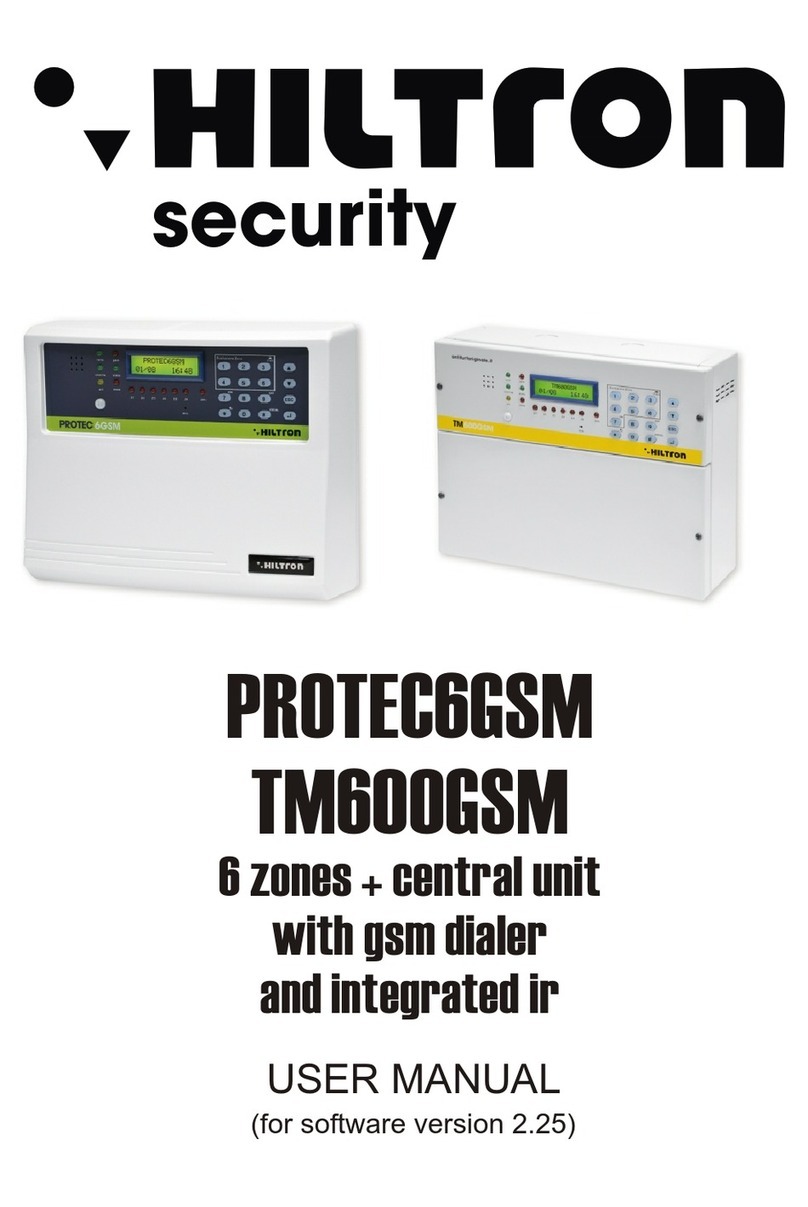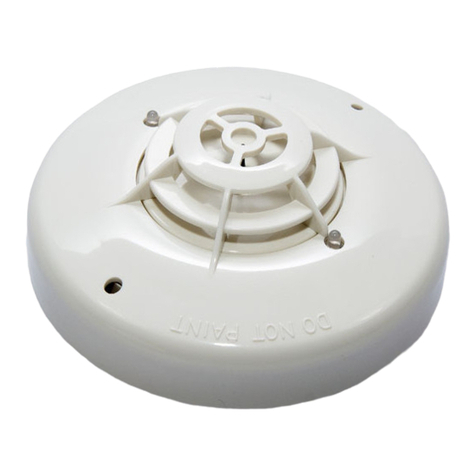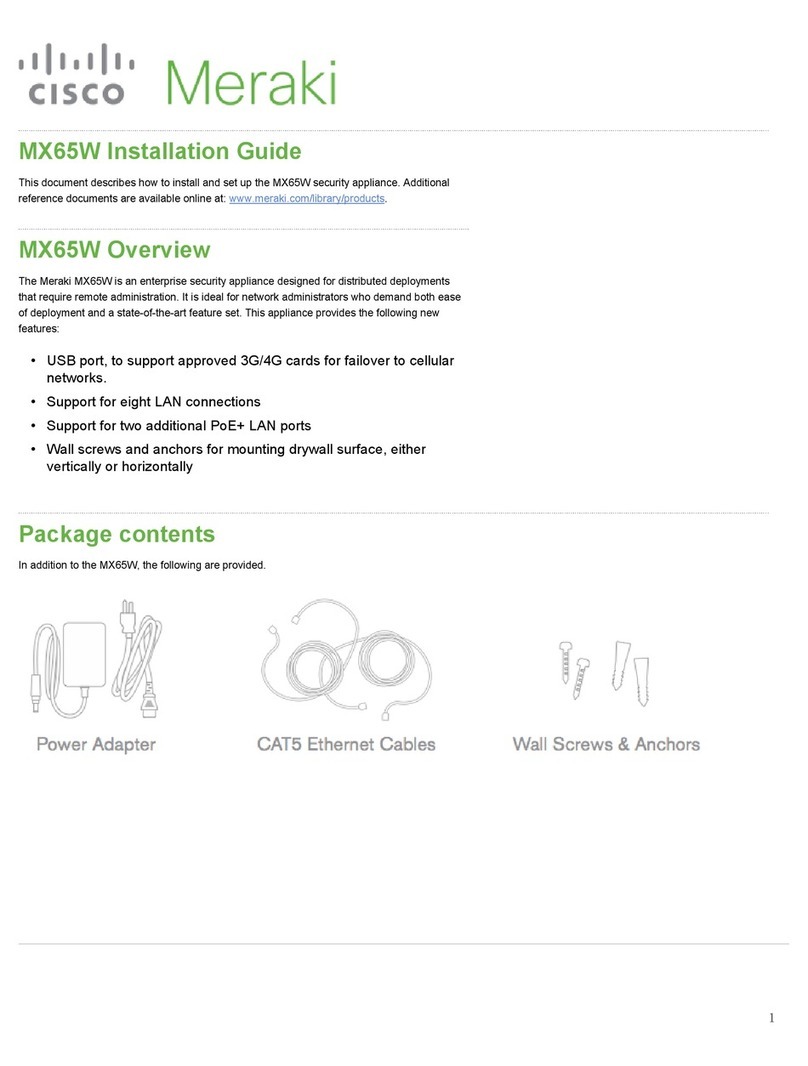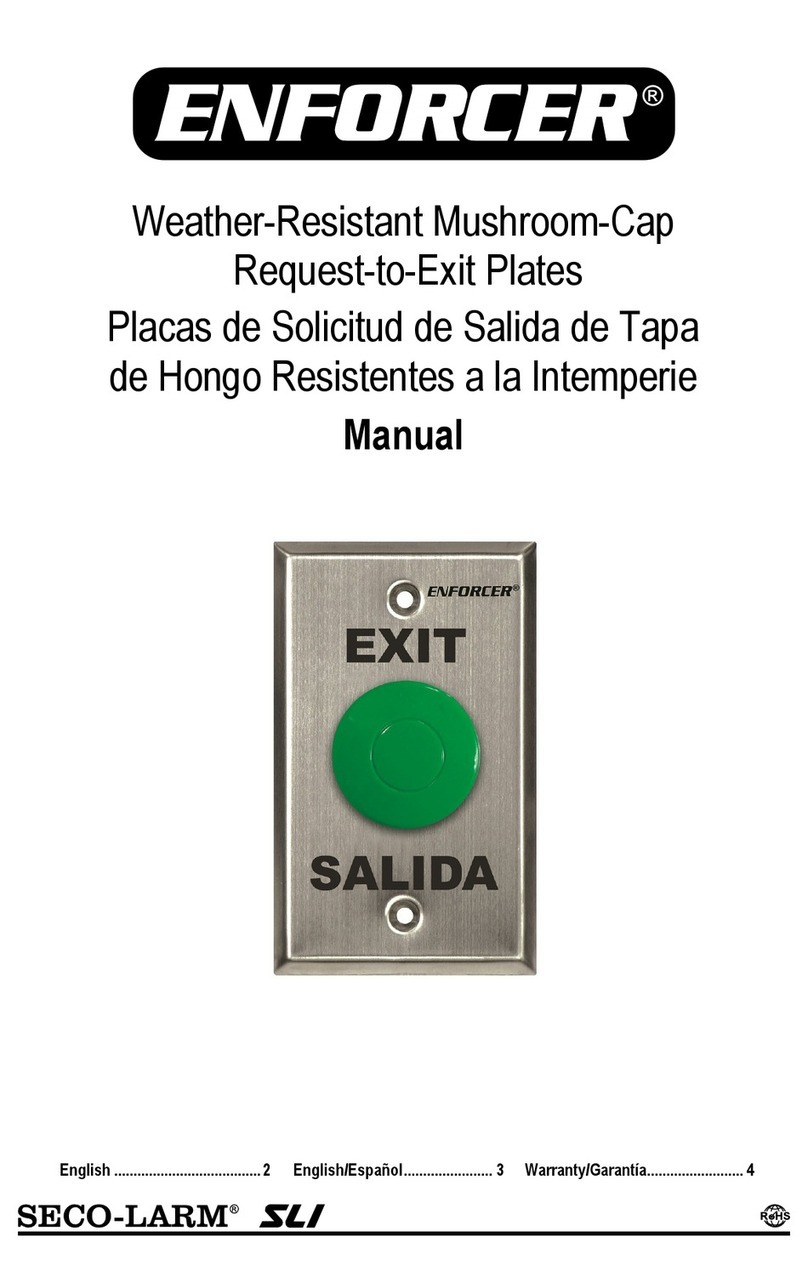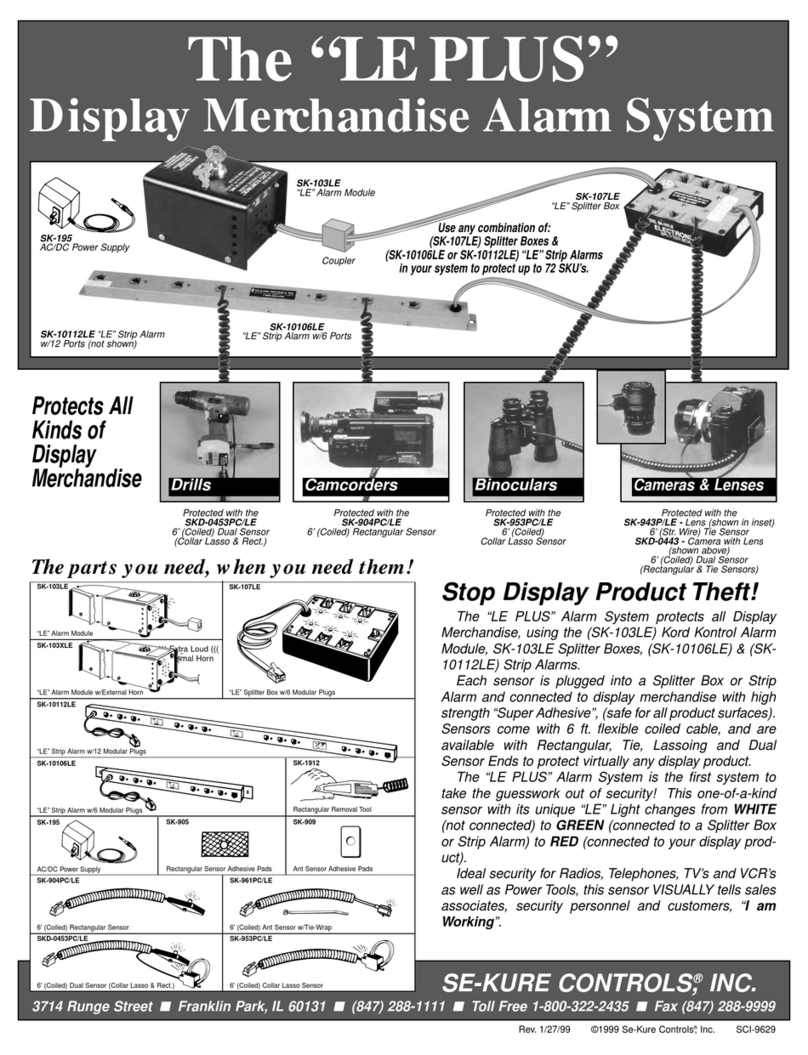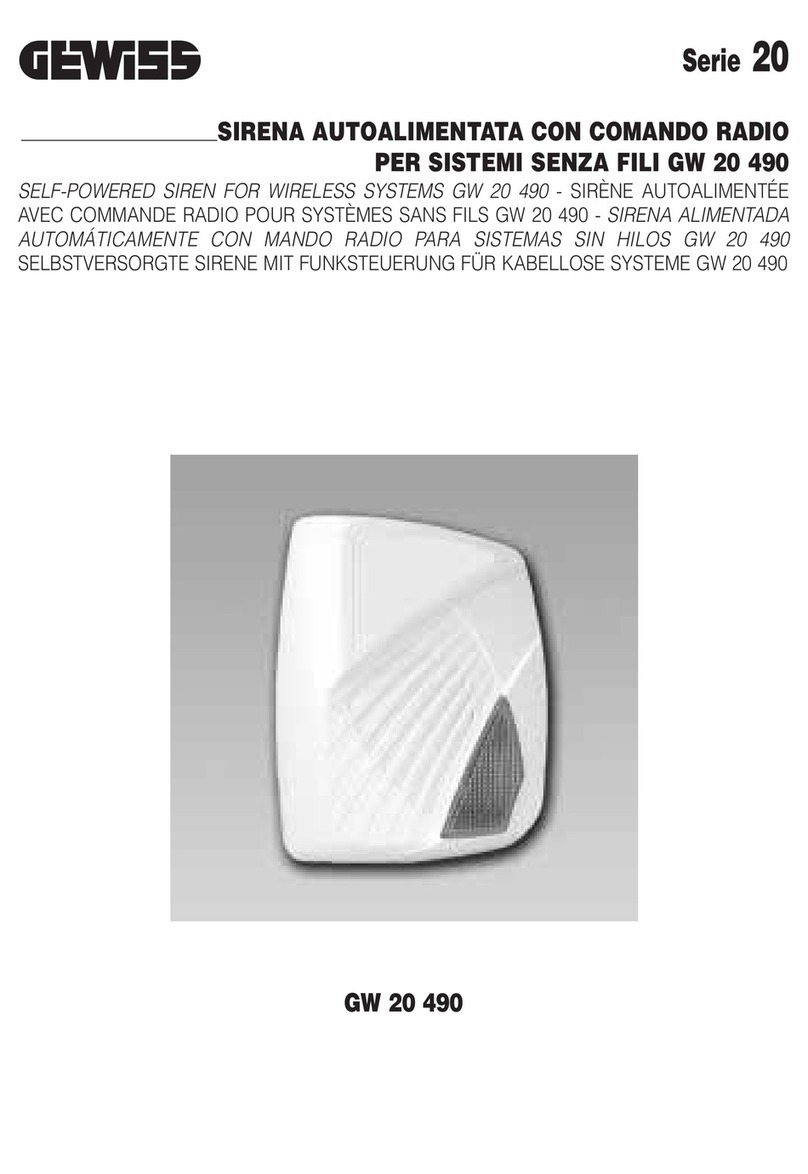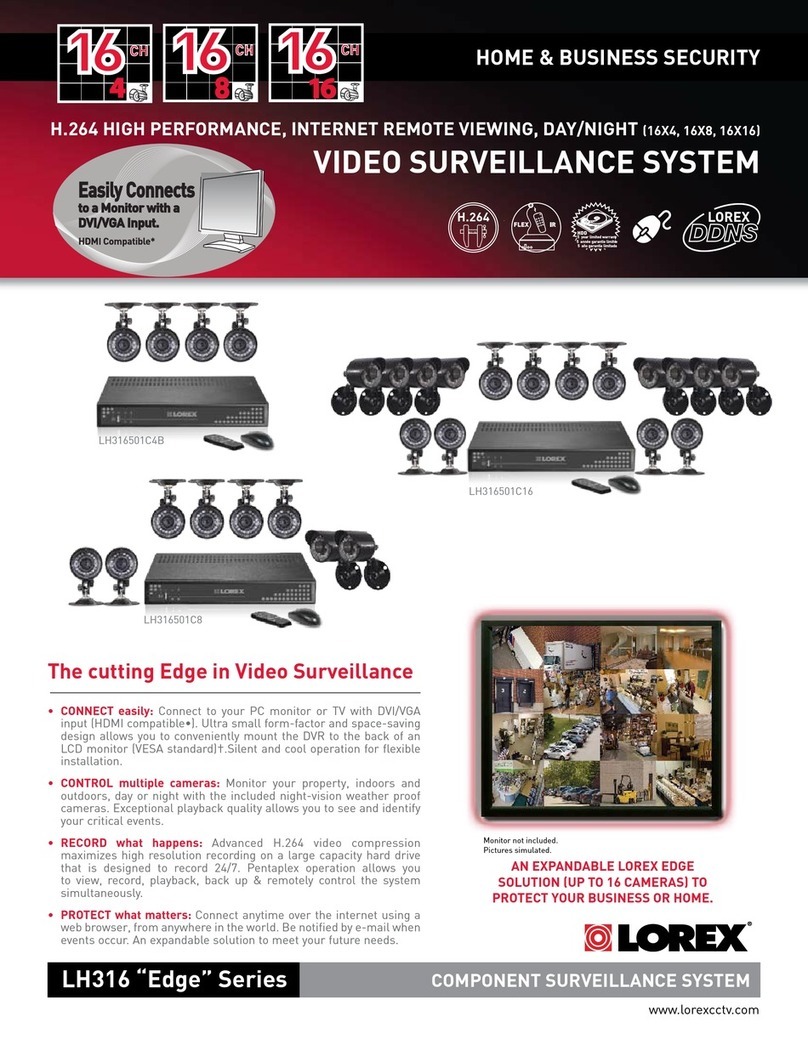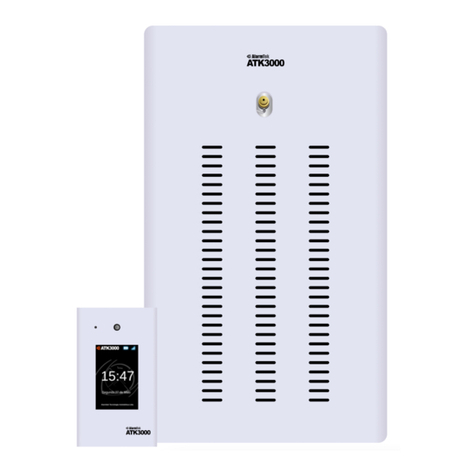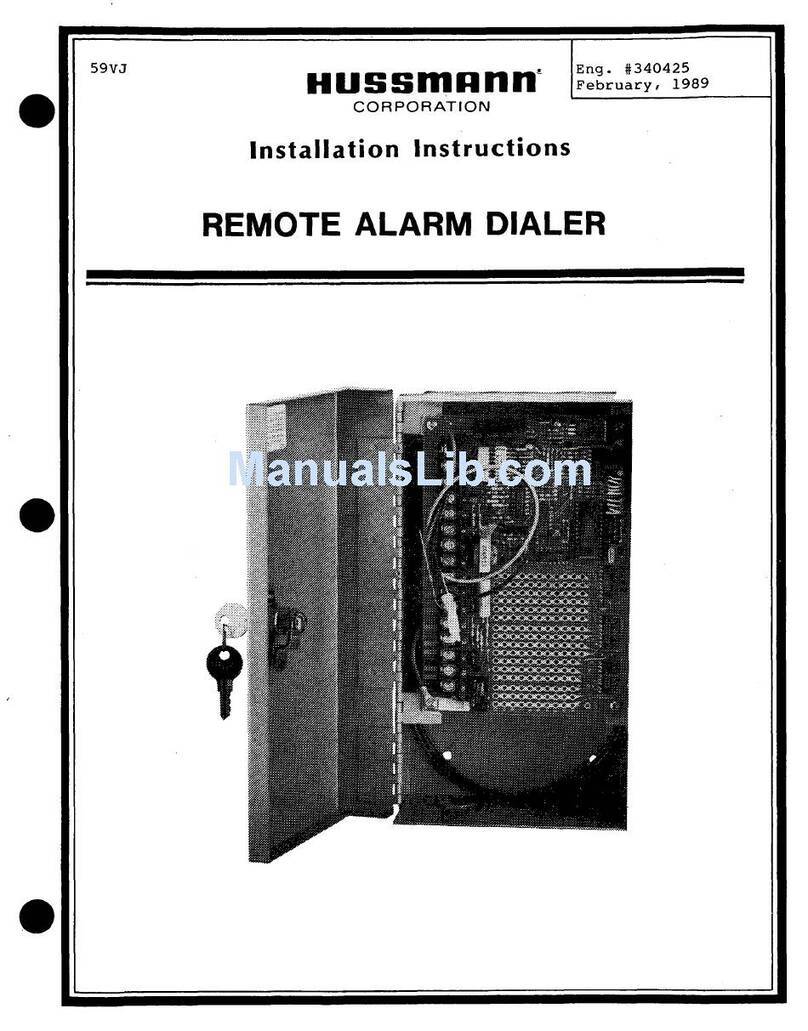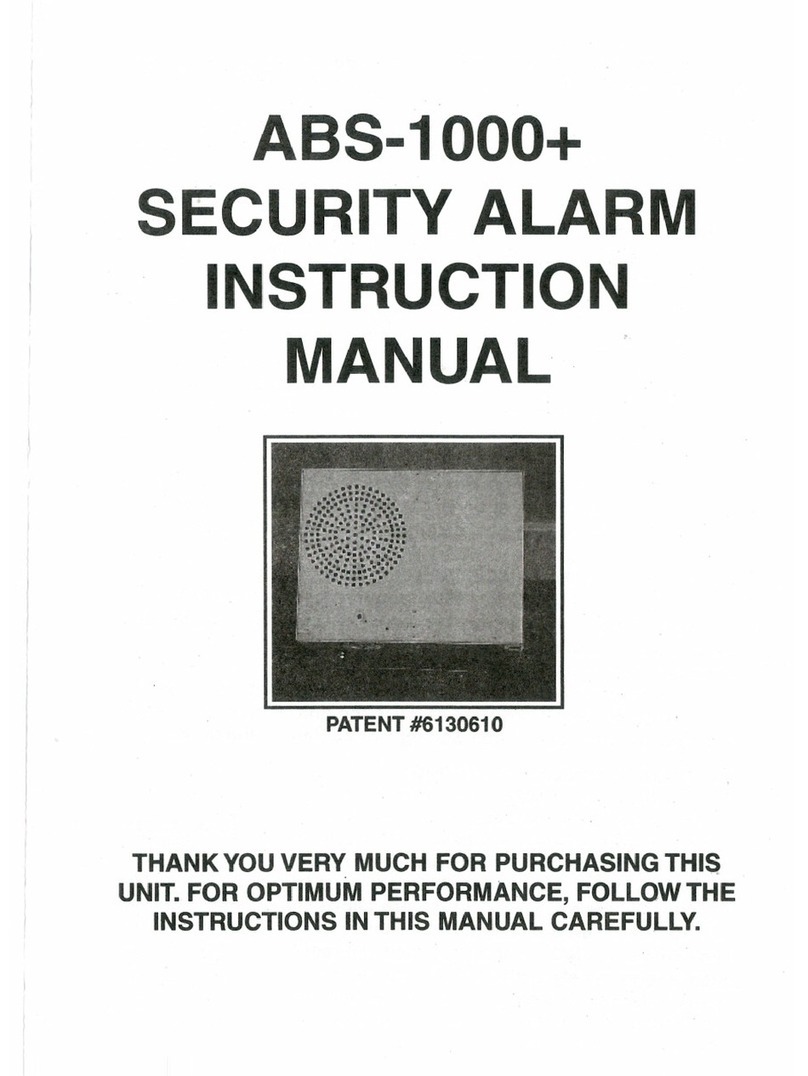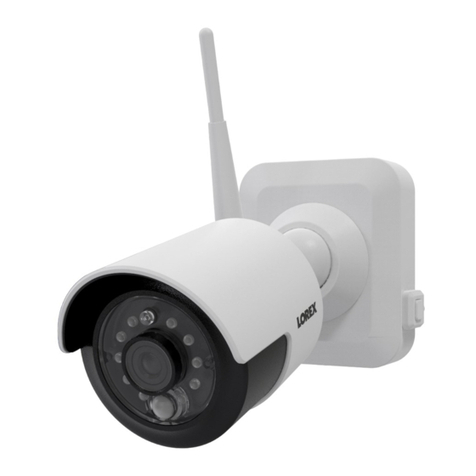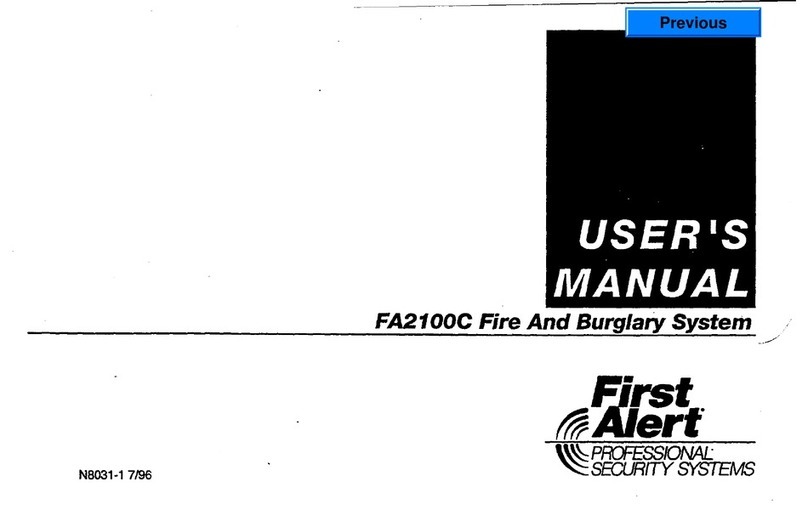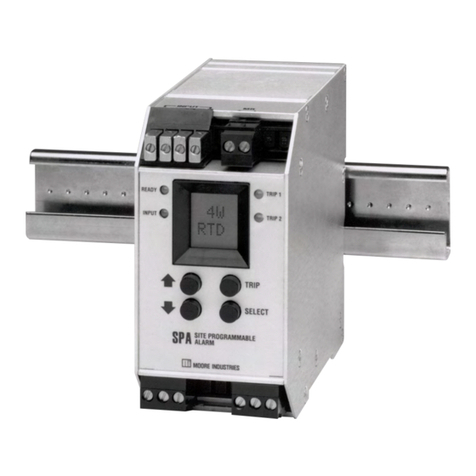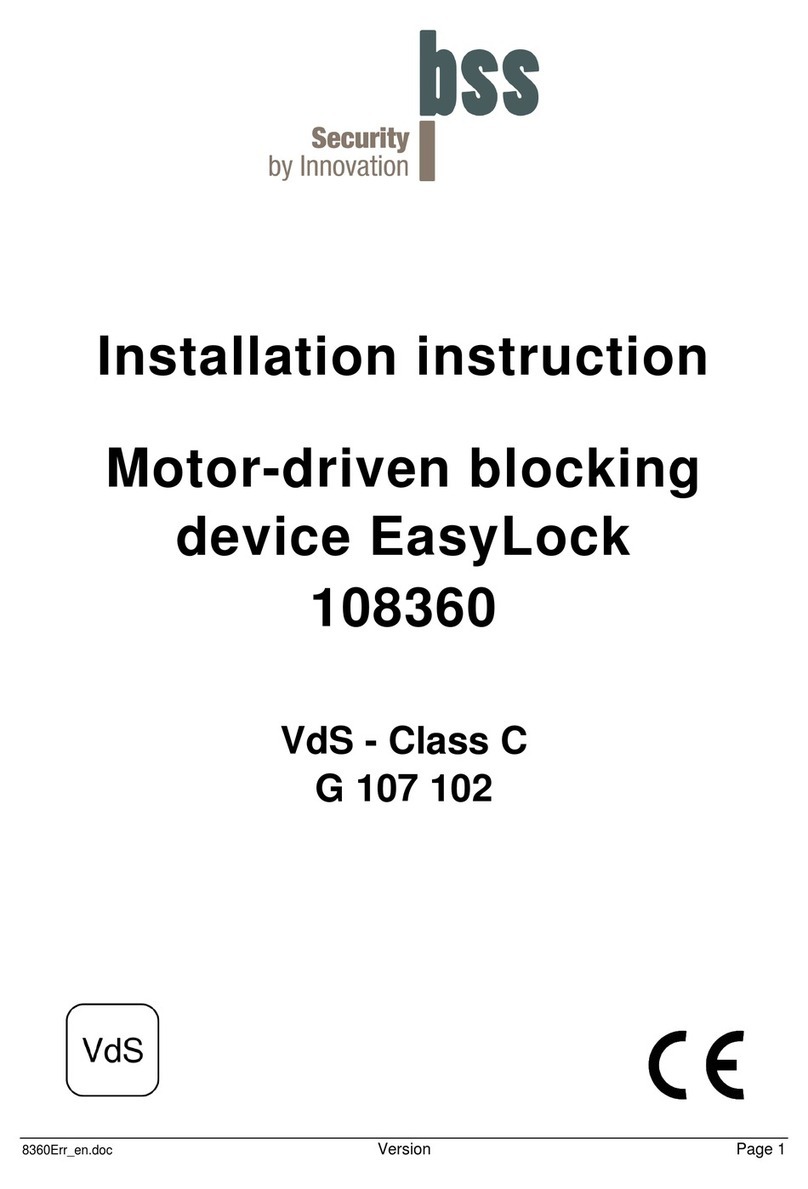Menvier Security SD1 User manual

SD1
Speech Dialler
Installation Instructions
B CA
ENT 0ESC
7 8 9
5 64
1 2 3
PLAYING PHRASE A
SD1

1. Overview
Connections: The SD1 is connected between the alarm control panel and the telephone
line. It behaves like another extension to the telephone and does not affect its normal
operation or that ofany other extension fitted. However, if theSD1 is operatingthemessages
will be heard if any handset is lifted. The unit requires no batteries as its power and mains
fail back-up are derived from the alarm control panel.
The SD1 accepts three inputs which in our example are; A - Fire, B - Personal Attack (PA) and
C - Burglary. These correspond to the messages (A, B and C) that the SD1 sends out and
should be recorded as such. If the control panel does not have a fire monitoring capability
thentheSD1willacceptadirectconnectionfromasuitablesmokealarm(asabove). Trigger
inputs can be selected as +ve or -ve applied. The SD1 may also be included in the control
panel tamper circuit.
Telephone Numbers: The SD1 will dial up to three different telephone numbers and play
its message. The numbers may be up to 16 digits long and are simply programmed using
the text display and keypad on the unit. Note: Emergency Services numbers cannot be
programmed.
Messages: The SD1 has a built-in microphone and speaker so that phrases can be
recorded and replayed directly from the unit. When the out-going call is answered the SD1
playsacommon phrase(0)andoneof thethreealarmmessages(phrasesA,Bor C). Phrase
0 states the identity name and address of the users and phrases A, B and C relate to the
inputs from the control panel (Fire, PA, and Burglary in our example). Each phrase can be
up to 8 seconds long giving a total possible message length of 16 seconds (0 + A, B or C).
Acknowledgement: On receiving a call from the SD1 the person answering acknowledges
it by pressing the number [8] on their telephone*. The SD1 may be programmed to stop
dialling after the first call has been acknowledged or when two or three have been
acknowledged, as required.
If the message is not acknowledged then it is repeated four times after which the dialler
abandons the call. It then dials the next number. This procedure is repeated three times
in sequence for all three telephone numbers. If no acknowledgement has been received
then the dialler shuts down.* Certain older types of telephone may require a tone dialling
simulator to do this.
1 2 3
456
7 8 9
0
B A
C
Control Panel Speech Dialler BT Line
Tel No 1
Tel No 2
Tel No 3
Telephone

2. Installation Requirements
The SD1 has been designed to be connected to an intruder alarm control panel or similar.
The control panel must have an auxiliary power output of between 11.5V and 14V, and the
ability to provide a minimum of 100mA.
The unit is supplied with a 2 meter telephone lead which will plug directly into any standard
BT. socket and it is therefore recommended that the unit is sited as near to a BT. telephone
socket as possible. If this it not possible an approved BT. extension lead may be required or
the unit can be hard wired to the BT. socket (see section 8).
3. Mounting Instructions
1. Separate the cover from the base by using a screwdriver to push two of the retaining
clips (top or bottom) inwards from the base indents. Remove cover assembly and store
in a safe place.
2. Holdthebaseinposition(keyholetothetop)andmarkthethreesecuringholes.Remove
the base then drill and plug the holes.
3. Pass all cables into the base through the cable entries and then secure the base to
wall.
4. PCB Layout
Tamperswitch
Loudspeaker
TriggerInput
Terminals
12VPowerInput
Terminals
Microphone
A
BOX
TAMPER
TRIGA
TRIGB
TRIGC
+12V
0V
TRIGPOLARITY
+TriggerPolarity
Jumper-link
TelephoneLine
Connection
Terminals
BoxTamper
Terminals
B BC
TELEPHONECONNECTIONS
Plastic cover

5. SD1 Connections
Before any connections are made to the SD1 remove the power (battery and 240V mains)
from the control panel.
Connections are provided as follows:
TRIG A: When triggered, the unit starts the dialling sequence and sendsphrase 0
+ message A.
TRIG B: When triggered, the unit starts the dialling sequence and sendsphrase 0
+ message B.
TRIG C: When triggered, the unit starts the dialling sequence and sendsphrase 0
+ message C.
Trigger inputs can be selectedto be either +ve applied totrigger or -ve
applied to trigger. Set the "Trigger Polarity" jumper-link to the
appropriate position. The figure below shows the different types of
output types that can be connected to the SD1.
BOX TAMPER: These two terminals may be connected to the main tamper zone on
the alarm control panel, to provide Box Tamper protection for the SD1.
0V: Connect to a permanent 0V supply on the control panel.
+12V: Connect to a permanent +12V supply on the control panel.
+The SD1 requires power at all times. If the power is removed, even momentarily all the
telephone numbers and messages will be erased.
SD1 SD1
+12V +12V
TRIG POLARITY TRIG POLARITY
0V 0V
+ +
- -
TRIG A TRIG A
TRIG B TRIG B
TRIG C TRIG C
12V on alarm 0V on alarm
1K
resistor 1K
resistor
N.C.
Loop N.O.
Loop
N.O.
Loop N.C.
Loop
TRIG A = Normally Closed Input
TRIG B = Normally Open Input
TRIG C = Switched +ve Input
TRIG A = Normally Open Input
TRIG B = Normally Closed Input
TRIG C = Switched -ve Input

6. Control Panel Connections
The table below shows the connection details to various control panels.
Control Panel TRIG A
Fire TRIG B
PA TRIG C
Alarm Polarity Supply + Supply - Trigger
Type
Menvier TS400 Zone 4 Zone 5 ALM - Aux + Aux - 0V app.
Menvier TS500 N/A N/A TRG- - Aux + Aux - 0V app.
Menvier TS510 N/A OP 2 * OP 1 * - Aux + Aux - 0V app.
Menvier TS700/TS790/TS900 Digi 1 Digi 2 Digi 3 - Aux+ Aux - 0V app.
A1 Advantage N/A N/A Bell - - Aux + Aux - 0V app.
ADE Optima XM N/A N/A B - 13V + 13V - 0V app.
ADE Optima 2+ Fire PA Intruder - 13V + 13V - 0V app.
ADE Concept 6 N/A N/A B - 13V + 13V - 0V app.
ADE Accenta 6 N/A N/A B - 13V + 13V - 0V app.
Ademco Infra 6 N/A N/A 3 + Aux + Aux - 12V app.
Ademco Infra 16 1* 2 3 + Aux + Aux - 12V app.
C & K 700L N/A N/A S- - Aux + Aux - 0V app.
CQR Premia 9 FA * PA IA + Aux 12V Aux 0V 12V app.
DA Abacus 6 N/A N/A Bell - +12V 0V 0V app.
DA Abacus 8 N/A N/A Bell - +12V 0V 0V app.
Gardtec 500 Series N/A N/A Bell - - Power + Power - 0V app.
Gardtec 800 Series D1 * PA 12Hr - 12V 0V 0V app.
JSB Regent COM1 COM2 COM3 + 12V 0V 0V app.
Pyronix Paragon + /E N/A N/A BA - Aux + Aux - 0V app.
Pyronix Octagon N/A PA ALM - Aux + Aux - 0V app.
Pyronix Conqueror N/A N/A BA - Aux + Aux - 0V app.
Scantronic 9448 N/A COM 2 COM 3 - 12V 0V 5V rem.
Scantronic 9452/3 N/A COM 1 COM 3 - Aux 12V Aux 0V 5V rem.
Scantronic 9454 N/A COM 1 COM 3 - 12V 0V 5V rem.
Scantronic 9455 N/A COM 1 COM 3 - 12V 0V 5V rem.
Texecom Veritas R8 N/A N/A B - Aux + Aux - 0V app.
Texecom Veritas 8 Compact N/A N/A B - Aux + Aux - 0V app.
* Control panel output requires programming.
+When using the bell output to trigger the SD1, you may find that the external sounder is
partially triggered. If this is the case a 1K resistor will need to be connected between the
SD1 trigger input and +12V.

7. BT. Connections
1. Remove the centre PCB screw and remove the plastic cover over the telephone
connection terminals.
2. Connect telephone line using one of the methods shown below:
3. Replace the plastic cover over the telephone line connections.
+Failure to re-fit the plastic cover will contravene mandatory European standards
8. Commissioning and Testing
1. Clip the SD1 front cover onto the base taking care not to trap any cables.
2. Switch the power back on to the control panel (battery and mains) and replace cover.
3. The SD1 "beeps" every 30 seconds and the display shows: PLEASE RE-RECORD.
4. ToinitialisetheSD1pressandholdthe[keyfor6secondsthedisplaywillshow:READY.
The unit is now ready for programming and testing. Please refer to the Operating
Instructions for full details.
A
B
BC
White
Red
Blue
StandardBTtelephoneplug
SD1
A
B
BC
SD1
3
2
1
6
5
4
White/Blue
BT Master Jack (NTE5)
User accessible connections Cable type 1/0.5mm CW1308
Blue/White
Orange/White
Method 1 - Using the lead supplied
Method 2 - Hard wired connections

9. Tone Dialling simulators (Tone Pads)
For the acknowledgement procedure the SD1 "looks" for any tone between 600Hz and
1400Hz. This is supplied most reliably by the [8] button used for MF dialling although other
buttons may work if pressed accidentally.
If the recipients phone cannot produce a suitable tone then a Tone Dialling Simulator (Tone
Pad)must beused. Theseareavailable frommany highstreet electricalstores andalsofrom
specialist suppliers such as RS Components (stock code 252-841) and Maplin Electronics
(stock code CK25C).
10. Trouble-Shooting Guide
Problem The unit will not dial out.
Cause Number incorrectly dialled
Action Check the telephone number you are calling has been entered correctly.
Cause The SD1 is not compatible with PABXs that require a pause or wait for secondary
dial tone.
Action Program the unit to pulse dial (see Operating Instructions). If this does not solve
the problem the dialler must be connected to a direct telephone line.
Cause Incorrect telephone line connections.
Action Check the connections to the telephone line (see section 7).
Problem When the unit calls the recipient they can't acknowledge the unit by pressing
the number [8] button.
Cause Incorrect acknowledgement procedure.
Action Instruct the recipient in the correct procedure (see Operating Instructions).
Cause Incorrectly connected to the telephone socket.
Action Check that all three connections are correctly connected (see section 7).
Cause Incompatible telephone.
Action Call the recipient and ask them to press the number [8] button on theirtelephone
for 1 second. If you hear anything other than a 1 second tone, their telephone
is not capable of acknowledging the SD1 (see section 9).
Problem The recipient can't acknowledge the unit with a mobile telephone.
Cause Weak reception or incompatible telephone.
Action Mobile telephones will only work correctly if they are used in an area where the
reception is good. Also check their tone duration (see section 9).
Problem The SD1 will not trigger from the alarm panel.
Cause Incorrect polarity setting.
Action Check the jumper-link is set to the correct position (see section 5).
Cause Incorrect trigger voltage.
Action Measure trigger voltage and check connections ( see section 6).

11. Specifications
Power input: 11.5V - 14V
Current consumption: 35mA (standby); 70mA (Active)
Trigger inputs: A, B, C (+ve or -ve applied, input voltage 5 - 28V)
Phrases A,B,C,0: 8 seconds each sampled at 8KHz
Telephone Numbers: 3 x 16 digit telephone numbers
Case dimensions: 130(L) x 130(H) x 30(D) mm
REN value: 0
BT approvals: S/1100/3/P/502920
Unit designed to BS6301: 1989, BS6305: 1982, BS6789 and BS60950
18067 Drg No. 33:1159:00 Iss 06. Doc 01 January, 1997
MENVIER
SECURITY
Menvier Security Ltd.
Kenn Road, Clevedon, Bristol BS21 6LH
Tel: 01275 870078; Fax: 01275 343453
Other manuals for SD1
6
Table of contents
Other Menvier Security Security System manuals

Menvier Security
Menvier Security TS2500 Assembly instructions

Menvier Security
Menvier Security TS400 Operation manual
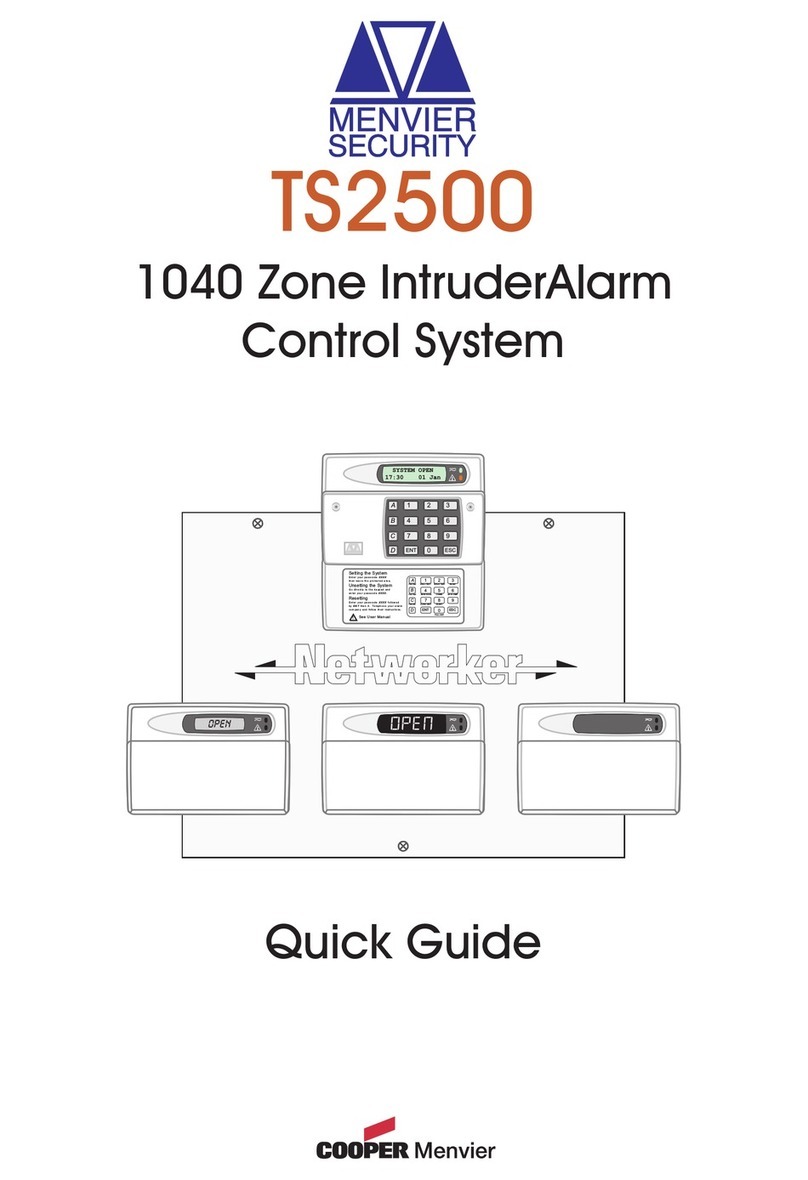
Menvier Security
Menvier Security TS2500 User manual
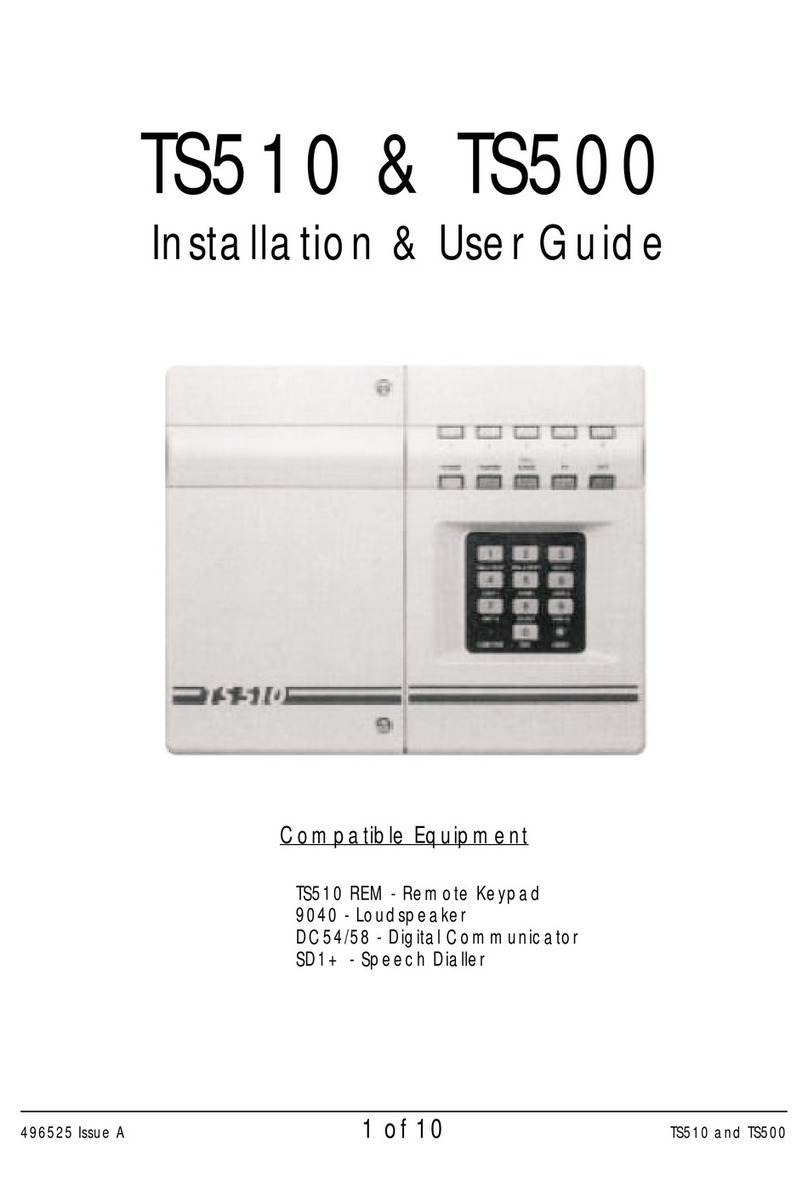
Menvier Security
Menvier Security TS510 Operation manual

Menvier Security
Menvier Security SD1 Installation guide
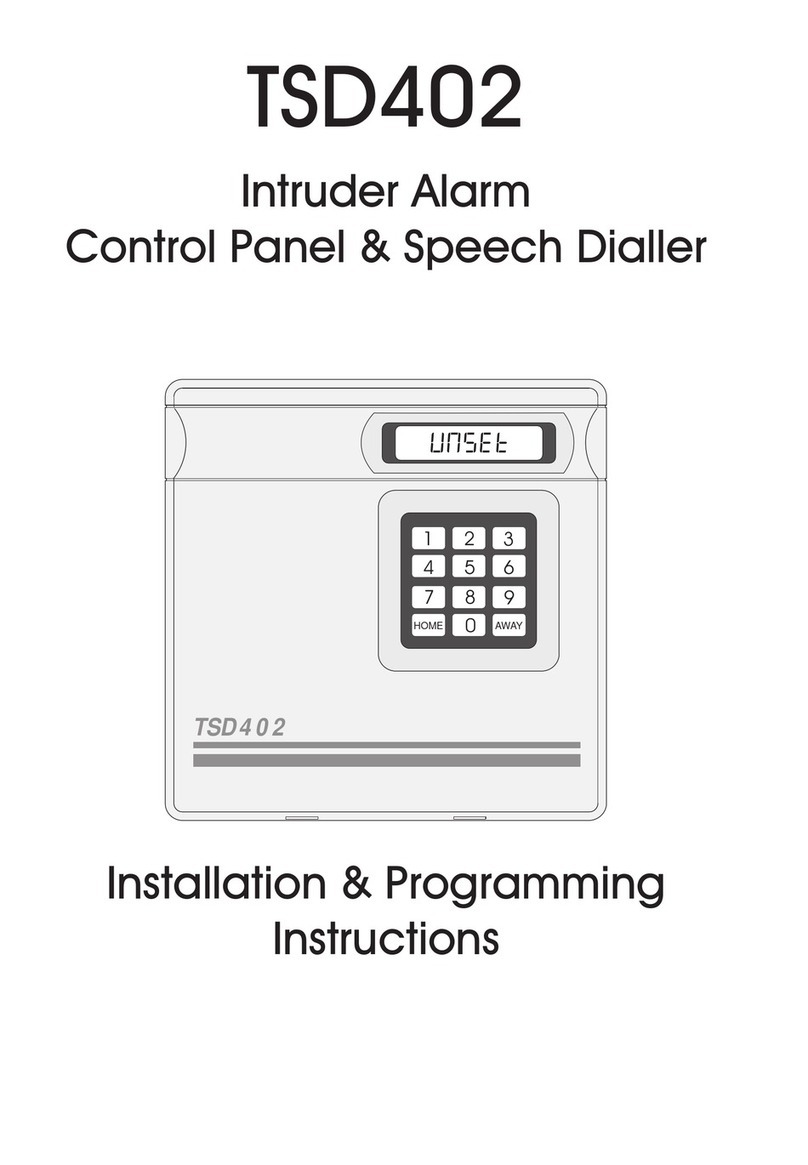
Menvier Security
Menvier Security TSD402 Installation manual
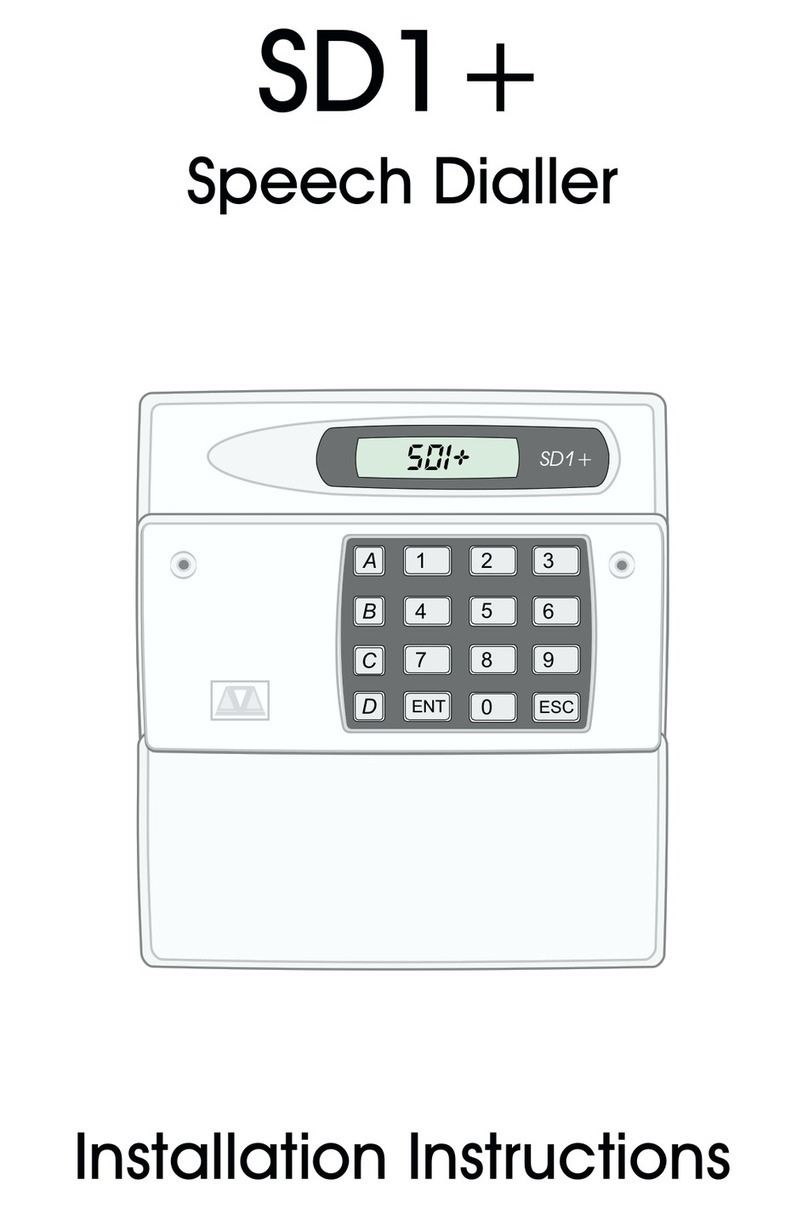
Menvier Security
Menvier Security SD1 User manual

Menvier Security
Menvier Security SD1 Manual

Menvier Security
Menvier Security TS2500 Assembly instructions

Menvier Security
Menvier Security TS2500 User manual

